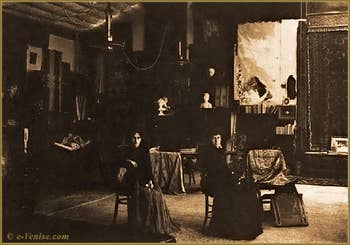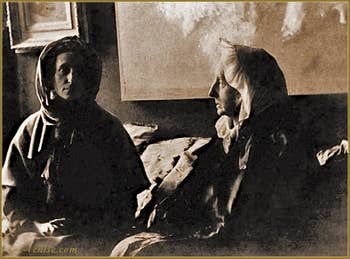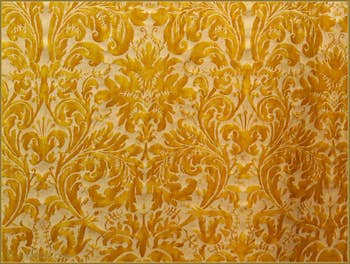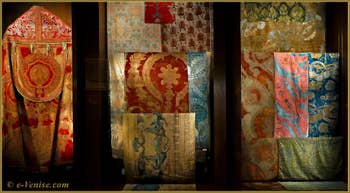Art Painters | Music | Literature | Video | Pictures
Painters Tintoretto | Titian | Canaletto | Fortuny | Albrecht Dürer |
Fortuny Museum Fortuny | Martinengo Orfei | Theatre | Clothes Fabrics | Photography Costume
Mariano Fortuny, the Magician of Venice: Fabrics, Dresses, Theatre and Photography
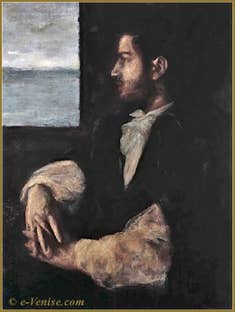
Self-portrait by Mariano Fortuny
Fortuny Museum Skip the Line Tickets
Smartphone Tickets AcceptedPalazzo Mariano Fortuny ➤
Mariano Fortuny, like Venice, had the ability to assimilate the most diverse cultures.
And he did not use this talent to confuse or dissolve them into a characterless, nameless melting pot.
On the contrary, he knew how to appreciate, meditate on and assimilate what was most noble and most beautiful about them.
This is how Mariano Fortuny's artistic sense was able to recreate original works that helped his contemporaries rediscover forgotten beauty.
A rediscovered beauty that lightly evoked the splendour of Venice's past.
Mariano Fortuny was born in Grenada in Spain, in 1871.
He moved to Venice with his mother as early as 1889, to the Palazzo Martinengo, on the banks of the Grand Canal.

Canvas by Mariano Fortuny, Parsifal, the ascent to the Grail He was only eighteen at the time, but already a young painter with a passion for theatre and opera.
And it was by observing the stage, with a painter's eye sensitive to the colours of the set and the effects of light on the costumes and actors, that this artist and inventor wanted to use the arts and techniques of modern times to enrich and perfect theatre and opera scenes.
Thus he invented his famous “coupole Fortuny” which combined the advantages of the new indirect lighting process he had developed with the possibility, thanks to this, of projecting coloured landscapes onto the wall of the white dome, whose shape also gave an impression of depth.
And to complete the set, he was also asked to find costumes for the actors (or singers), the style of which would be in perfect harmony with the work represented, to give it that beautiful unity capable of offering the spectator a moment of the most refined aesthetic pleasure possible...
Here again, it is the artist and the cultivated man who has drawn his inspiration from the styles and fashions of the past, and from diverse origins, to create magnificent fabrics, using natural pigments and traditional methods revised and modernised by techniques of his own invention.
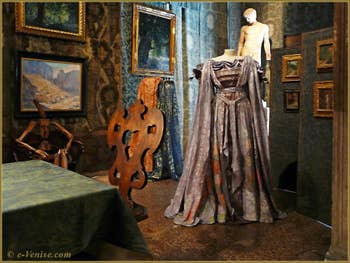
The Mariano Fortuny Museum His research and discoveries led to the creation of a style that was all the rage at one time, when his dresses were worn by famous artists such as Sarah Bernhardt and Eleonora Duse, who became his best ambassadors to high society ladies throughout Europe.
Such was his success that Mariano Fortuny soon found himself at the head of a workshop, or rather a small, highly specialised industry, if we consider the number of employees and the technical resources employed.
Artistic painter with a love of theatre and opera, who became scenographer and stylist, Mariano Fortuny was able to mobilise the most diverse means to put them at the service of artistic creation: painting, photography, electricity and fabric printing techniques.
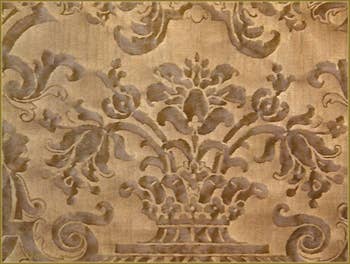
Fabric Mariano Fortuny “Carnavalet” Mariano Fortuny, the artist-inventor, worked in his studio-laboratory amidst his colours, his compositions of light, and his collection of beautiful objects that fed his inspiration: the Palazzo Pesaro degli Orfei, now the Fortuny Museum, served as both his home and his studio.
Known and appreciated by the people of the world, but indifferent as much to politics as to artistic fashions, Mariano Fortuny was not a “committed” artist, but a reserved man who rarely went out. His knowledge of the arts and techniques made him similar to the artists of the Renaissance, and his style seemed capable of transmuting vile materials into noble ones, in the manner of the alchemists.
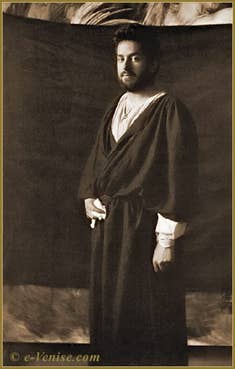
Self-portrait of Mariano Fortuny And it was precisely because he was able to restore to Venice all the beauty and splendour of its festivities of yesteryear, that he was nicknamed “the magician of Venice”.
Mariano Fortuny: a son of Artists Lovers of all the Arts
Mariano Fortuny's original and rather complex career has left us with the image of an astonishingly versatile artist, who was not, however, a man in search of the sensational, inaugurating a new fashion to ensure success and fame.The origin of all his inventions (Fortuny lamps and dome, etc.) and his very diverse artistic works (paintings, compositions of colours and patterns for his fabrics, styles of clothing...) lies rather in the sensitivity and curiosity of this man, who had the good fortune to live in a family of painters and art lovers who gave him an artistic education in keeping with his artistic and inventive spirit.
Mariano Fortuny was the son of the Spanish painter Mariano Fortuny y Marsal.
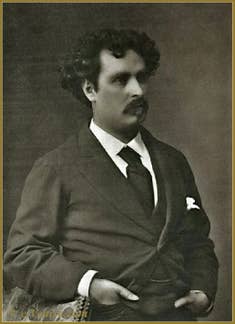
Mariano Fortuny's father His mother, Cecilia de Madrazo, belonged to a dynasty of artists who had worked in the service of the king of Spain.
His father was a well-known painter and lover of antiques.
In his youth Mariano Fortuny y Marsal was sent for a few months to Morocco, to illustrate the arms deeds of the Spanish army, which went to war against that country (His painting of the Battle of Tetouan was exhibited at the museum in Barcelona).
But battles interested him far less than the country itself: he preferred to wander through the alleyways of the Casbah to immerse himself in a new world, fascinated by the people, their customs and their arts.
He brought back a veritable collection of the finest local crafts: magnificently crafted weapons (muskets, scimitars, shields and Saracen spiked helmets), copper trays, fabrics and carpets, sandals, shiny babouches...
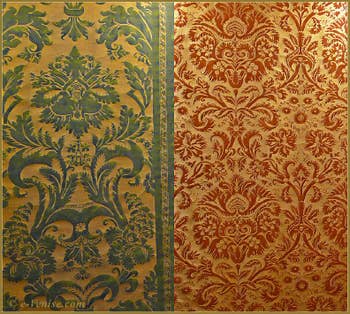
Fabrics Mariano Fortuny, “Glicine” and “de Medici” So many colours and beautiful materials that he would later install in his workshop in Rome where he painted, engraved, and had made some fine goldsmithing pieces, including dagger handles and sword pommels.
Before settling in Rome, he had lived for some time in Paris, where he had frequented painters and men of letters such as Jean-Louis-Ernest Meissonnier and Théophile Gautier, who appreciated his art of etching and said of him:
“As an aquafortist, Fortuny equalled Goya and came close to Rembrandt. ”
It was among his compatriots settled in Paris, that Mariano Fortuny's father met his wife, Cecilia de Madrazo, daughter of Federico de Madrazo, portrait painter and curator of the Royal Museum of Madrid, and sister of Raimundo, also a painter.
Mariano Fortuny Sr, while following in the footsteps of the great Renaissance artists, also admired the Impressionists and wanted first and foremost to paint for himself.
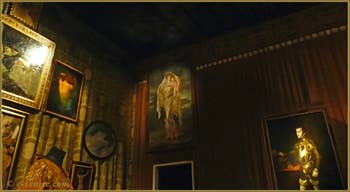
Museo Mariano Fortuny Palazzo Pesaro degli Orfei He lived in Rome with his wife Cecilia and two children, Mariano and Maria Luisa; and it was amidst his extraordinary collection that he worked and received his students.
One photo shows us the Romantic artist meditating amidst all these objects belonging to the past, and which have lost their usefulness in the modern
world. It's a veritable “cabinet of curiosities” in nineteenth-century fashion, a museum-studio, where a painting is born that explores the past and distant, exotic spaces.
A museum-studio similar to the one his son would build for himself when he moved to the Palazzo degli Orfei in Venice.
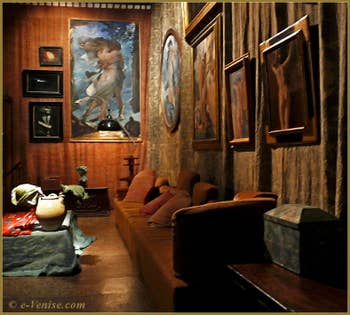
Mariano Fortuny's home museum Mariano Fortuny Sr's study was also a meeting place for art lovers and the Roman elite...
Sadly, Mariano Fortuny's father was only thirty-six when he died in 1874.
Cecilia left Rome for Paris and moved to Avenue des Champs Elysées with the children, to be with her brother Raimundo de Madrazo, who would play an important role in the education of her nephew Mariano.
Childhood and Adolescence in Paris among artists
Painting
By the age of nine, Mariano was already announcing a certain talent by making a copy of a painting by Diego Velázquez.He received notions of sculpture in the studio of Auguste Rodin, but his teachers were above all his uncle and painters who were friends of his late father, such as Benjamin-Constant, whose studio he assiduously frequented from 1876 to 1885.
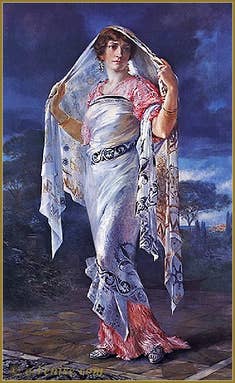
Henrietta shawl “Knossos” These painters were proponents of an epic realism sometimes inspired by the Italian Renaissance; Mariano Fortuny inherited from them a mimetic conception of painting, which functioned as an illustration and memory of places rather than an expression of feelings, and whose apparent realism had more to do with the imaginary than with analysis.
The Theatre
Giovanni Boldini, an old friend of his father's, took him to see the ballets spectacles of Eden, open since 1883.His interest in the show turned into a passion when he discovered backstage.
Mariano immediately began studying everything to do with the stage: electricity and optics for lighting and effects, the construction of small theatre models for the sets, and the actors' costumes to find a style in harmony with the work being performed.
Wagner's Opera
Added to all this were the currents of thought in this end of the 19th century: some were looking for an ideological corpus offering, through the union of the arts, a new proposal for life and society, taking refuge in metaphysical conceptions where the arts tended towards Beauty, towards the pure Ideal, thus becoming the language of an elite of initiates who shared the same passion.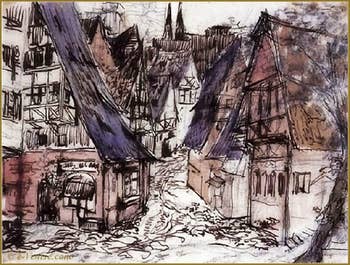
Sketch Richard Wagner's The Master Singers Wagner's concept of the total work of art, in which music, voice, choreography, costumes, sets, space and light would form the most harmonious whole possible, was the perfect answer to this aspiration.
And it was a passionate fan of Wagner, the Spanish painter and musician Rogelio de Egusquiza, who pushed Mariano Fortuny towards the Wagnerian aesthetic by speaking to him enthusiastically about his work on his return from Bayreuth.
Mariano Fortuny had this to say about him:
“The person who had the most influence in transporting me to the world of theatre was the Spanish painter Egusquiza.
[...] during that winter he spoke to me only of the myths and heroes of the Ring [...] I dreamt only of Wagner.
[...] I was absorbed by the scenes and sets, and it was a strong reminder to me to return to the study of painting.”
Fortuny
All these events of his Parisian childhood and adolescence were decisive for Mariano Fortuny's artistic career.
Mariano Fortuny in Venice, his mother and sister Maria Luisa

Mariano Fortuny, series on the four elements: air Cécilia Fortuny y Madrazo had long wanted to settle in Venice.
In 1889 she moved into the palais Martinengo, (in the Dorsoduro, at number 178, facing the Grand Canal) where she led a secluded life, devoted to the cult of the memory of her husband and the love of art.
Mariano was then eighteen years old.
Cécilia Fortuny y Madrazo liked to entertain artists and writers there:
Isaac Albéniz, Jose Maria de Heredia, and later: Henri de Régnier, Reynaldo Hahn, Marcel Proust, and Paul Morand.
She had a collection of magnificent antique fabrics that Henri de Régnier had the pleasure of admiring when he visited her in the early 1900s.
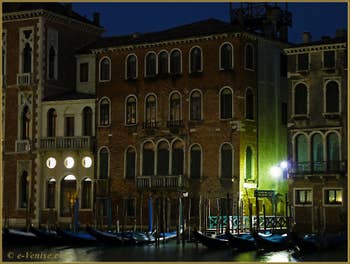
Palazzo Martinengo on Venice Grand Canal Henri de Régnier gives us a description of the Palazzo Martinengo and shares his admiration for Madame Cecilia Fortuny's rich collection of antique fabrics:
“Is this the beautiful and sumptuous star from which “Gentile Bellini” hung the stiff and rich on the support of the marble loggia that frames with its fine colonnettes and elegant arch his portrait of the sultan Mahomet II?
Was it the magic carpet of fairy tales that transported us to the threshold of this old palace, whose grey rendered facade shines out into the Grand Canal, its severe lines offering the eye none of the Byzantine or Moresque ornamentation with which the graceful and bizarre fantasy of Venetian Gothic is adorned?
This former Palazzo Martinengo in San Gregorio does indeed date back to the 15th century, but its sturdy frame has more strength than grace.
In its greyish, twilight appearance, and despite the master gondola that usually waits moored to its pali, it almost looks uninhabited.
The door, however, will open for us.
Mrs Fortuny, who has lived in this gracious house for many years, would like to welcome us and show us the admirable collection of antique fabrics she has assembled there.
Here we are in the grand gallery of the Palais Fortuny.
Maria Luisa Fortuny and Cecilia de Madrazo It is a long, vast room with a high ceiling supported by large beams.
On the walls hang many brilliant sketches by Fortuny and interesting studies by his son Mariano, who is here to introduce us to his mother.
Mrs Fortuny welcomes us with perfect graciousness.
She and her daughter lead a particularly sedentary life in Venice.
They hardly ever leave their palace.
Do they even go down into the inner courtyard that I saw as I entered, where melancholy pigeons coo on the damp flagstones?
Despite its strict confines, the Palais Fortuny is very hospitable, offering guests succulent Valencian cuisine and intricate pastries. Mrs Fortuny is assisted by her daughter.
These two Venetians have retained a very Spanish appearance.
Maria Luisa Fortuny and Cecilia de Madrazo Their fine hands are capable of handling the fan and the rosary, and I can already imagine them feeling the marvellous fabrics promised with the same devotion with which they caress the magnificent Moresque cassette made of carved ivory and which, placed on a table, seems, under its barbaric fittings, to contain, next to some secret philtre, who knows what mysterious grimoire of magic.
It is indeed a scene of magic that we are about to witness, in this silent old palace that the nearby bells of the Salute seem to exorcise with their incantatory voices.
Mrs Fortuny admits that she has always had a taste for ancient fabrics, the smallest shred of which, having escaped the ravages of time, evokes their unspoilt splendour.
It was in Spain that she made her first purchase: an antique velvet, the blood-reddish purple of which was decorated with burst pomegranates.
This first purchase was followed by many others, and little by little the marvellous collection took shape.
In Venice, offers come mainly in winter.
Often some old Venetian woman comes to the Palace and pulls out from under her shawl a precious shred, a family relic, a remnant of the past that adds its testimony to the memory of all those beautiful luxuries that have disappeared.
Fabric Mariano Fortuny “Lucrezia” But Mrs Fortuny and her daughter approached a large chest in the corner of the room and lifted the heavy lid.
There, in a slow, cautious gesture, lay the fabrics they were pulling out, softly folded or carefully spread out.
Suddenly the first one appears.
It's an admirable fifteenth-century velvet, dark blue, embossed with arabesques of great style, a velvet of a strange, muted, deep and pure blue that is like the very garment of the night.
Then, slowly, the magical operation continues and, once unfolded and seen, the beautiful fabrics wait on the back of an armchair, on the slope of a sofa, for the moment to take their place again in the asylum of the great cassone that shelters them. One by one, they come out.
Here are the heavy velvets of Venice, Genoa or the Orient, sumptuous and delicate, bright or serious, with ample branches, figures or foliage, velvets that may have clothed Doges or Khalifs.
Here are brocades in powerful tones, silks in subtle shades; here are church ornaments and court finery.
Here are the charming taffetas and shiny satins, strewn with flowers and bouquets, which the 15th century used to make its women's dresses and its men's clothes.
Cape and Fabrics Mariano Fortuny Here are fabrics of all shades and fabrics, some evoking the shape of the bodies they clothed, others in long pieces and strips, some in tatters, in thin fragments.
And all this, with the rustling of invisible wings, piling up, piling up in the vast room gradually darkened by the hour, while, leaning over the deep inexhaustible chest Mrs Fortuny seems to direct with her magician's gesture the astonishing concert of fabrics which, in the depths of this old palace, is mysteriously played out in the silence of the Venetian twilight...”
Henri de Régnier - “Venetian Life” 1899 - 1924
Of course, Mariano was perfectly familiar with all these fabrics, having always been able to see them, touch them, feel them and admire them at his leisure.
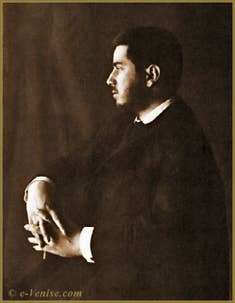
Mariano Fortuny Self-Portrait All this splendour was familiar to him and part of the house, it became a source of inspiration at hand for his creations of theatrical costumes, and fabrics that he wanted to be as beautiful as his mother's.
Mariano Fortuny's first exhibitions and first successes
in Venice, Mariano continued to paint and to take an equal interest in theatre and electric lighting, music and photography.He also studied the art of engraving and, following the Venetian tradition as far as painting was concerned, he learned to copy the great masters, perfecting the art of mixing colours.
By frequenting the intellectual circles of Venice, Mariano Fortuny would meet personalities who would be of great importance to his subsequent career, including Angelo Conti, who had taken the debate on art criticism to a philosophical and aesthetic level, and who contributed to his intellectual training.

Theatre set model for the “Casanova” And in 1894 he met Gabriele D'Annunzio, then Eleonora Duse, a close friend and performer of Duse's works.
Indeed, Mariano also frequented Prince Fritz Hohenlohe Waldembourg and his wife Zina, who liked to entertain at their “Casetta Rossa” Hugo Von Hofmannsthal and Gabriele D'Annunzio.
In 1892 the young painter discovered Bayreuth with his family, to rediscover the work of Wagner, which had already seduced him thanks to his friend Egusquiza.
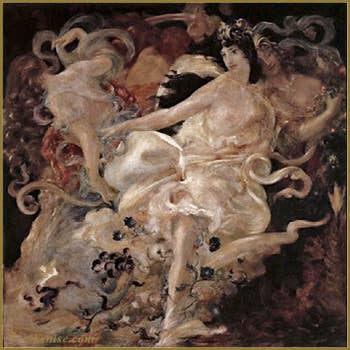
Young Flower Girls by Mariano Fortuny
But he was struck above all by the visual and scenographic aspect of Wagner's opera, and he understood at once that the union of painting with scenography could form part of the great project of the total work of art.
Mariano Fortuny thus set about creating a whole series of paintings illustrating the great Wagnerian themes.
These included the “Fanciulle Fiore”, Young Flower Girls, which won first prize at the Munich International Exhibition of 1896.
At the Biennale di Venezia of 1899, he exhibited a portrait of Zina, painted in the 18th-century English style.
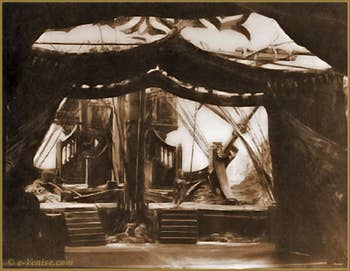
Theatre set by Mariano Fortuny for Wagner And he again presented his “Jeunes Filles Fleurs” as well as two female portraits, again with Wagnerian themes, at the Salon de la Société Nationale des Beaux Arts de Paris.
At the Exposition Universelle de Paris of 1900, he represented Spain and was awarded a silver medal.
At the same time, he had successfully handled the set design for an operetta “Mikado” for the private theatre of the Countess Albrizzi in Venice, so much so that the famous librettist Giuseppe Giacosa asked him to make the models for Tristan and Isolde, which was to be performed for the first time in Italy, at the Scala in Milan.
In 1900 Mariano Fortuny moved into the Palazzo Pesaro degli Orfei, which was to become the Fortuny Museum
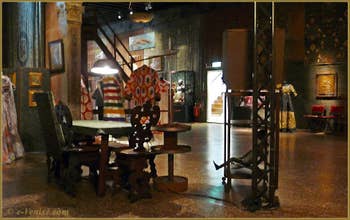
Mariano Fortuny's Palazzo Pesaro Museum Mariano Fortuny needed several studios in order to be able to carry out work as different as painting, photography, making theatre models, and to experiment with lighting.
To carry out his projects he bought the top floor of Palazzo Pesaro degli Orfei, which at the time was inhabited by modest families, and whose ground floor was filled with shops and craftsmen's workshops.
Palazzo Pesaro was a fifteenth-century Venetian Florentine Gothic palace, once owned by Girolamo Pesaro, a galley commander who took part in the Battle of the Dardanelles against the Turks.
Situated on Campo San Beneto (Sestier de San Marco), it was the venue for numerous festivities, concerts and performances during the glorious era of sixteenth-century Venice.

Fortuny “Caravaggio” Plaute was recited here; and the famous “Compagnia della Calza”, also known as the Ortolani, had a comedy by Ruzzante performed here in 1520.
Later it was called Pesaro-Orfei because it had become the headquarters of the Philharmonic Society of the Orfei from 1786 to 1826, when it transferred to La Fenice.
When Mariano Fortuny moved there in 1900, it was no more than a dilapidated building inhabited by numerous families; three hundred and fifty people were thus housed in this palace sadly cut up into small flats.
Little by little, Mariano Fortuny restored it to its original character by bringing the interior rooms back to their original dimensions, eventually owning it in its entirety in August 1931.
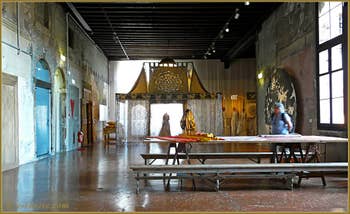
The Palazzo Pesaro in Venice His palace was thus able to offer him the double pleasure of living in a superb flat on the noble floor, and of having a vast workspace thanks to the many rooms that became workshops dedicated specifically to each of his activities: painting, photography, engraving, carpentry, fabric dyeing and printing, pleating, sewing...
A beehive where fabrics are transformed into works of art amid the noise of silk printing and the heat of pleating machines, where the voices of the workers mingle with the smells of pigments and colour fixatives.
A secret laboratory, where the master of the house meditates and draws inspiration from the past, where he invents and makes so many original things.
All this work of transmutation and invention carried out by Mariano Fortuny restored the Palazzo Pesaro degli Orfei to its former richness and nobility.
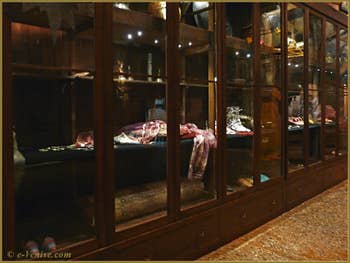
The Mariano Fortuny Museum in Venice
“Mariano Fortuny was to be found at work when we went to see him at his magnificent Palazzo Orfei in San Benedetto.
In this lofty and austere building, one of the most complete of the Venetian quattrocento, he had set up his dyeing and embroidery workshops, his workshop for decorative fabrics and clothing, where the sure ingenuity of his invention adapted ancient fabric models to modern uses without altering their character and style.
Silks, velvets, brocades and printed fabrics were used for hangings and clothing.
Mariano Fortuny had given the ancient Palazzo Orfei an artistic life and activity worthy of the days of ancient Venice, while respecting its somewhat off-putting beauty.”
Henri de Régnier - Venetian Life 1899 - 1924
Fortuny Museum Fortuny | Martinengo Orfei | Theatre | Clothes Fabrics | Photography Costume
Painters Tintoretto | Titian | Canaletto | Fortuny | Albrecht Dürer |
Art Painters | Music | Literature | Video | Pictures
Back to Top of Page


